-
Technical Paper
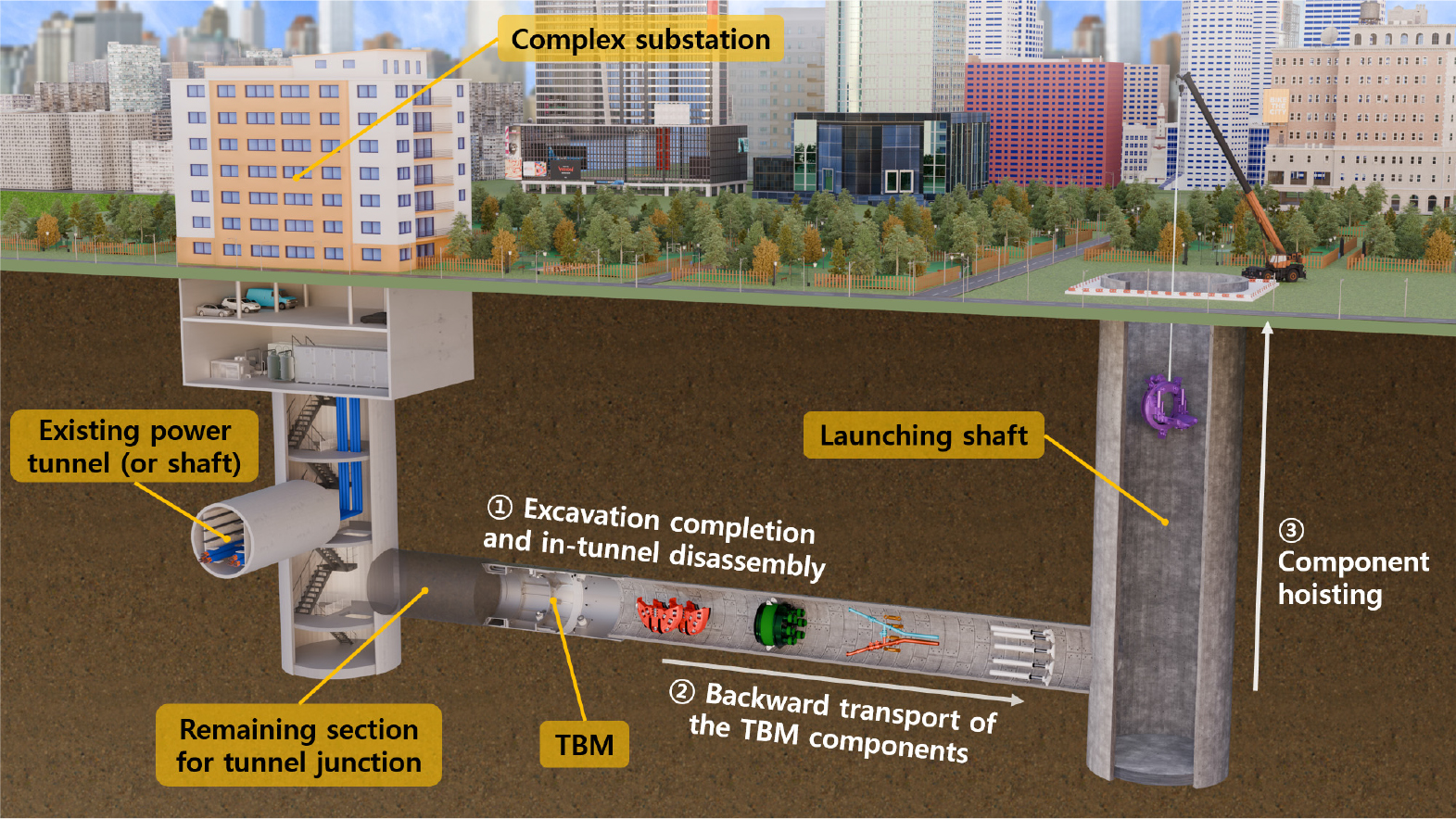
-
Case study of domestic and overseas applications for TBM in-tunnel disassembly and parts recovery
국내·외 TBM 갱내 해체 및 부품 회수 적용 사례 조사
-
Dong-Joon Youn, Haejin Lee, Tae-Zin Ahn, Hee-Hwan Ryu, Jung-Joo Kim, Shin-Kyu Choi
윤동준, 이해진, 안태진, 류희환, 김정주, 최신규
- This study investigated domestic and overseas cases of in-tunnel tunnel boring machine (TBM) disassembly, where the machine is disassembled inside the tunnel …
터널굴착기계(tunnel boring machine, TBM)가 도달 수직구 없이 터널 내부에서 해체되고 후방을 통해 반출되는 갱내 해체의 국내·외 사례를 조사하고 각 사례의 제반 조건과 …
- This study investigated domestic and overseas cases of in-tunnel tunnel boring machine (TBM) disassembly, where the machine is disassembled inside the tunnel and subsequently recovered through the rear without a vertical shaft. Specifically, this analysis identified the factors governing the selection of the disassembly method and the essential engineering considerations based on the site-specific conditions encountered in each case. In South Korea, power distribution tunnel construction projects in urban areas, which have a relatively high adoption rate of the mechanized tunneling method, account for the majority of in-tunnel disassembly cases, with their primary purpose being the construction of connecting tunnels that form junctions to the existing operational tunnels or vertical shafts for power cable distribution. As the omission of vertical shafts enables cost reduction and minimizes construction site occupation, while providing various operational advantages including reduced noise and vibration during construction, the adaptation of in-tunnel disassembly is anticipated to increase rapidly in the future. Contrary to the connecting power distribution tunnels shown in the domestic examples, applications in the excavation or extension of transportation and utility tunnels were identified in the overseas cases. With respect to these applications, it was found that in-tunnel disassembly was implement when vertical shaft construction was difficult due to site-specific constraints such as tunnel depth and geometry, water table, construction methods, and adjacent structures. The influencing factors and considerations related to the constraints were analyzed and summarized in this paper.
- COLLAPSE
터널굴착기계(tunnel boring machine, TBM)가 도달 수직구 없이 터널 내부에서 해체되고 후방을 통해 반출되는 갱내 해체의 국내·외 사례를 조사하고 각 사례의 제반 조건과 이에 따른 해체 방법 및 주안점을 분석하였다. 국내에서는 기계화 굴착공법의 적용율이 상대적으로 높은 도심지 내 전력구 공사가 갱내 해체 사례의 대부분을 차지하며, 특히 공사가 완료되어 운용 중인 기존 전력구 터널이나 수직구에 분기를 형성하는 접속터널의 시공에 주로 활용되는 특징을 가진다. 이 경우 수직구 생략이 가능하여 공사비 절감과 공사부지 점용 최소화에 더해 공사 과정에서 발생하는 소음 및 진동의 저감 등 여러 공정상의 장점이 있으므로 향후 TBM의 갱내 해체공법 적용 사례가 빠르게 증가할 것으로 예상한다. 터널 내 수용시설 분배를 위한 접속터널 형성을 목적으로 하는 국내 사례와 달리 해외의 경우 교통 혹은 기타 사회 기반 시설용 터널의 굴착과 연장에 다양하게 적용된 사례를 확인하였다. 이와 관련하여 갱내 해체공법이 각 현장의 터널 심도와 형태, 지하수위, 공사방식, 인근 기설 구조물과 같은 공사 여건상의 제약으로 인해 수직구 건설이 어려운 경우에 적용된 점을 확인하고 이에 대한 영향 요소와 주안점을 함께 정리하였다.
-
Case study of domestic and overseas applications for TBM in-tunnel disassembly and parts recovery
-
Technical Paper

-
A policy study on establishing underground shelter standards utilizing subsurface space in Seoul for responding to complex threats
서울시 지하공간을 활용한 복합위협 대응용 지하대피시설 기준 마련을 위한 정책연구
-
Jae-Chun Sim, Joon-Shik Moon, Myungha Hwang, Hyoung-Seok Oh, Jinwoo Jung
심재춘, 문준식, 황명하, 오형석, 정진우
- This study aims to develop practical underground shelter standards capable of responding to compound threats such as nuclear attacks, weapon of mass …
본 연구는 핵, 대량살상무기(weapon of mass destruction, WMD), 전자기펄스(electromagnetic pulse, EMP) 등 복합 위협에 대응하기 위한 실질적 생존 기반의 지하 대피시설 기준을 …
- This study aims to develop practical underground shelter standards capable of responding to compound threats such as nuclear attacks, weapon of mass destruction (WMD), and electromagnetic pulse (EMP). By examining Israel’s protective space systems, the research evaluates the potential for utilizing urban underground spaces for civil defense purposes and identifies the limitations of Seoul’s current shelter infrastructure. The findings indicate that Seoul’s shelters suffer from shallow depth, insufficient protective performance, and a lack of institutional design standards. Accordingly, this study proposes several policy measures, including amendments to building regulations, expansion of deep underground shelters, establishment of design guidelines by facility type, introduction of a protective-facility certification system, and institutionalization of an Urban Defense Plan. These measures together represent an integrated urban-survival strategy that promotes the dual use of tunnels and underground infrastructure for protective purposes, thereby enhancing national security and civilian survivability through the multifunctional use of underground space.
- COLLAPSE
본 연구는 핵, 대량살상무기(weapon of mass destruction, WMD), 전자기펄스(electromagnetic pulse, EMP) 등 복합 위협에 대응하기 위한 실질적 생존 기반의 지하 대피시설 기준을 마련하기 위한 연구를 목적으로 한다. 특히 이스라엘의 방호 공간 사례를 통해 도시 내 지하공간의 방호적 활용 가능성을 분석하고, 서울시의 현행 대피체계의 한계를 진단하였다. 연구 결과, 서울시 대피시설은 얕은 심도, 방호성능 미비, 제도적 기준 부재 등의 문제를 안고 있으며, 이에 본 연구는 건축법 개정, 대심도 대피소 확충, 시설유형별 설계 기준 정립, 방호시설 인증제 도입, 도시방호계획 제도화 등의 정책방안을 제시하였다. 이는 터널 및 지하공간 인프라를 방호목적과 병행 활용하는 통합적 도시생존 전략의 일환으로, 향후 지하공간의 다기능적 이용을 통해 국가안보 및 시민 생존성 제고에 기여할 수 있을 것이다.
-
A policy study on establishing underground shelter standards utilizing subsurface space in Seoul for responding to complex threats
-
Research Paper
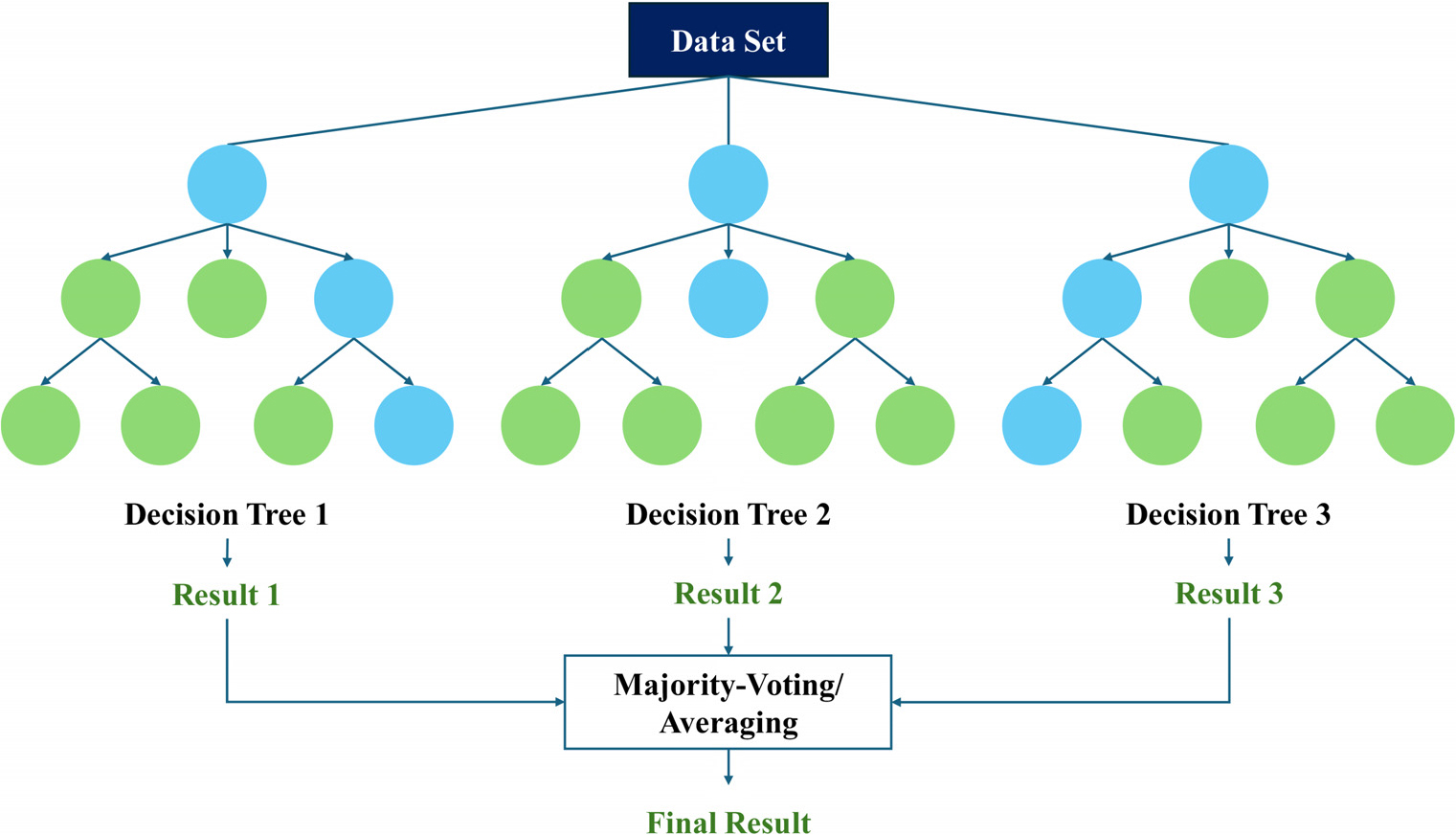
-
Machine learning model for predicting the roadheader performance
로드헤더의 굴진속도 예측을 위한 머신러닝 모델
-
Jin-Won Seo, Ki-Il Song, Pok-Hwan Bae
서진원, 송기일, 배복환
- The development of underground space has been actively promoted worldwide to address urban overcrowding and mechanized tunneling methods are increasingly encouraged in …
전 세계적으로 도심지 과밀화 문제를 해결하기 위해 지하공간 개발이 활발히 추진되고 있으며, 도심지에서의 소음과 발파 민원을 해결하기 위해 기계식 터널 굴착 공법을 …
- The development of underground space has been actively promoted worldwide to address urban overcrowding and mechanized tunneling methods are increasingly encouraged in urban areas to mitigate noise and blasting-related complaints. Among these methods, the roadheader tunneling technique has attracted attention due to its adaptability to varying tunnel cross-sectional shapes and high mobility. However, to ensure process efficiency under diverse rock conditions, it is essential to establish a reliable approach for accurately predicting the cutting performance of roadheaders. In this study, ground condition and excavation data from a large-scale roadheader tunneling project in Korea were collected and analyzed to develop predictive models using five machine learning techniques: Random Forest (RF), eXtreme Gradient Boosting (XGBoost), K-Nearest Neighbor (KNN), Deep Neural Network (DNN), and Tabular Prior-Data Fitted Network (TabPFN). Rock strength, pick consumption per face, and advance length were selected as input features, and suitable hyperparameters were tuned for model construction. A total of 135 datasets were divided into training and test sets at an 8:2 ratio. Comparative analysis of model performance showed that the DNN and TabPFN models achieved relatively superior results, with coefficients of determination (R2) of 0.68 and 0.72, and root mean square error (RMSE) of 1.43 and 1.34, mean absolute error (MAE) of 1.04 and 1.07, respectively.
- COLLAPSE
전 세계적으로 도심지 과밀화 문제를 해결하기 위해 지하공간 개발이 활발히 추진되고 있으며, 도심지에서의 소음과 발파 민원을 해결하기 위해 기계식 터널 굴착 공법을 장려하고 있다. 그 중 터널 단면 형상 변화에 대한 대응력과 이동성이 우수한 로드헤더 공법이 주목받고 있으며, 다양한 암반 조건에 대응하고, 공정의 효율성을 확보하기 위해서는 로드헤더의 굴진 성능을 정확하게 예측할 수 있는 방안이 필요하다. 본 연구에서는 국내 대형 로드헤더 터널 시공 현장의 지반 조건 및 굴진 데이터를 수집하여 분석하고, Random Forest (RF), eXtreme Gradient Boosting (XGBoost), K-Nearest Neighbor (KNN), Deep Neural Network (DNN), Tabular Prior-Data Fitted Network (TabPFN)의 5가지 머신러닝 기법을 이용하여 굴진속도 예측 모델을 개발하였다. 예측 모델의 입력 특성으로 암반 강도, 막장당 피크 소모량, 굴진장을 선정하였으며, 수집된 데이터셋에 적합한 하이퍼파라미터를 탐색하여 모델을 구축하였다. 총 135개의 데이터셋을 학습 데이터와 테스트 데이터를 각각 8:2 비율로 나누어 학습하고, 학습 성능을 비교·분석한 결과 DNN과 TabPFN 모델이 각각 0.68, 0.72의 결정계수(R2)와 1.43, 1.34의 평균 제곱근 오차(root mean square error, RMSE), 1.04, 1.07의 평균 절대 오차(mean absolute error, MAE)로 비교적 우수한 결과를 나타냈다.
-
Machine learning model for predicting the roadheader performance
-
Research Paper
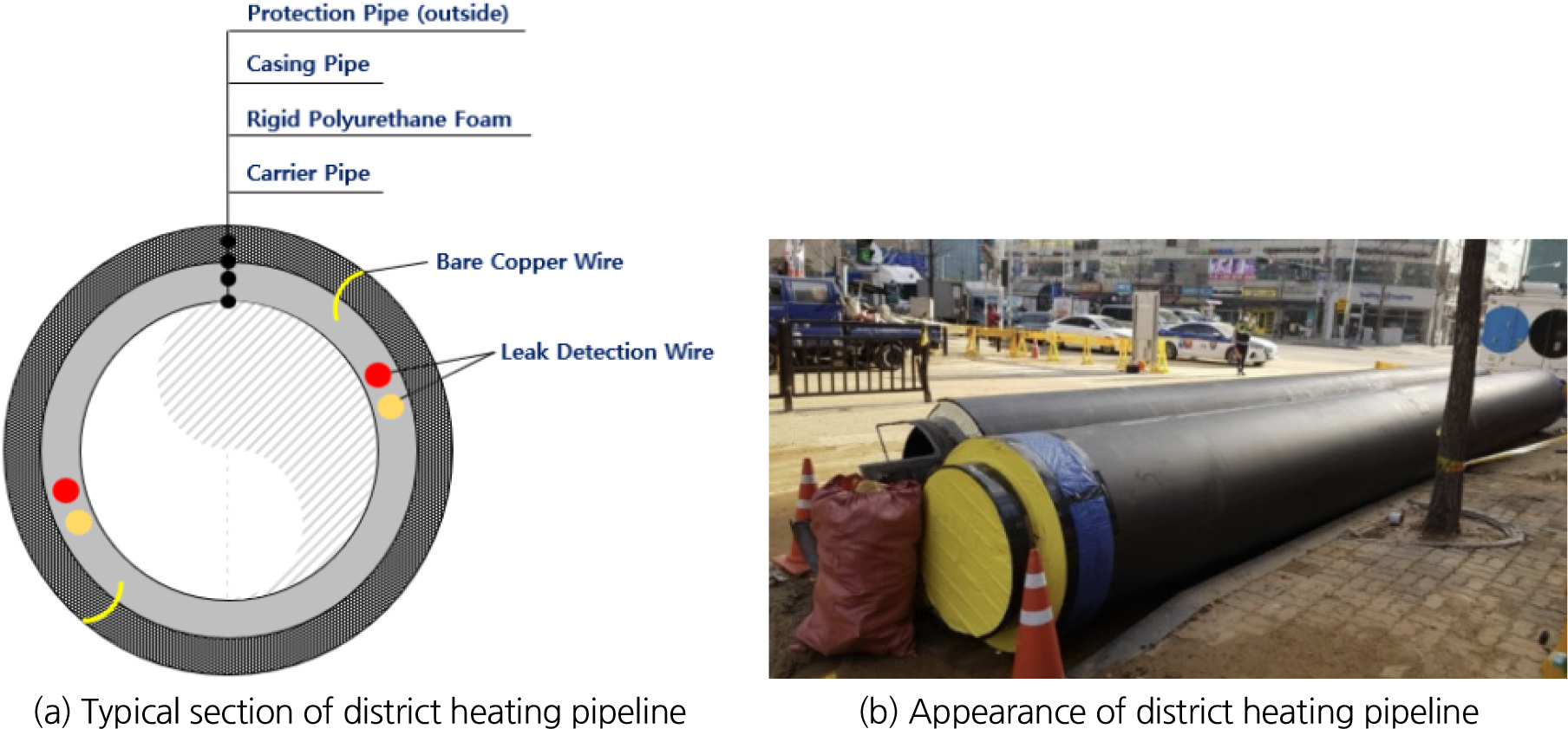
-
Seismic behavior of buried energy line considering soil-structure interaction
지반-구조물 상호작용을 고려한 매설 에너지라인의 지진 시 동적거동
-
Chang-Won Kwak
곽창원
- Prominent energy lines, such as district heating pipelines, are being designed, constructed, and maintained by 29 district energy operators nationwide, with a …
대표적인 에너지라인인 열수송관은 29개 집단에너지사업자가 전국적으로 설계, 시공 및 유지관리 중이며 총 길이 4,720 km × 2열(2022년 기준)로서 전국 주요 도시에서 총 …
- Prominent energy lines, such as district heating pipelines, are being designed, constructed, and maintained by 29 district energy operators nationwide, with a total length of 4,720 km × 2 lines (as of 2022). These pipelines supply a massive amount of thermal energy, 39,128 Gcal/h (as of the end of 2021), directly to 3.4 million households in major cities across the country, serving as critical national infrastructure. Following the 2018 Goyang district heating pipeline accident, these pipelines have been recognized as high-risk facilities. Therefore, the safe design, construction, and maintenance of district heating pipelines are directly linked to public safety and convenience. To ensure this, district heating pipelines must be designed based on clear engineering principles. In particular, to ensure safety against the recent surge in medium-sized earthquakes in Korea, seismic design reviews must be conducted in accordance with seismic design regulations (Enforcement Decree of the Act on Countermeasures against Earthquakes and Volcanic Eruptions). However, the seismic design criteria for district heating pipelines have been established without thoroughly considering geotechnical factors such as soil displacement and soil-structure interaction, focusing only on structural engineering aspects like axial strain. This makes the current criteria insufficient for assessing engineering stability, necessitating supplementary research. This study aims to understand the dynamic behavior of district heating pipelines during earthquakes by performing dynamic numerical analysis using the finite difference method. By considering the interaction between the soil and the pipeline structure, we obtain and analyze reliable dynamic behavior, providing a basis for improving the current seismic design criteria that rely solely on longitudinal pipe deformation.
- COLLAPSE
대표적인 에너지라인인 열수송관은 29개 집단에너지사업자가 전국적으로 설계, 시공 및 유지관리 중이며 총 길이 4,720 km × 2열(2022년 기준)로서 전국 주요 도시에서 총 340만 세대에 39,128 Gcal/h (2021년 말 기준)의 막대한 열에너지를 직접 수요처로 공급하는 주요 국가 기간설비이며 2018년 고양 열수송관 사고를 계기로 고위험 시설물로 인식되고 있다. 따라서 열수송관의 안전한 설계, 시공 및 유지관리는 국민 안전 및 생활 편의성과 직결되며 이를 위하여 열수송관은 명확한 공학적 근거를 바탕으로 설계되어야 한다. 특히 최근 국내에 급증하고 있는 중규모 지진에 대하여 안전성을 확보할 수 있도록 열수송관은 내진설계규정(지진·화산재해대책법)에 의거하여 내진안전성 검토를 수행하여야 한다. 그러나 열수송관의 내진설계 기준은 지반변위, 지반-구조물 상호작용 등 지반공학적 영향인자가 심도있게 고려되지 못한 채 구조공학적 요소인 축방향 변형률만을 검토하여 지진에 대한 안정성 여부를 판단하도록 제정되어 공학적 안정성을 판단하기에 부족한 실정이므로 이에 대한 보완적 연구가 절실히 요구된다. 본 연구에서는 열수송관의 지진 시 동적거동을 파악하기 위하여 유한차분해석법에 의한 동적수치해석을 수행함으로서 지반-열수송관 구조물 상호작용을 고려한 신뢰도 높은 동적 거동을 획득하고 분석함으로서 현재 단순히 종방향 관변형률에 의존하는 내진설계 기준에 대한 개선 근거를 확보하였다.
-
Seismic behavior of buried energy line considering soil-structure interaction
-
Research Paper
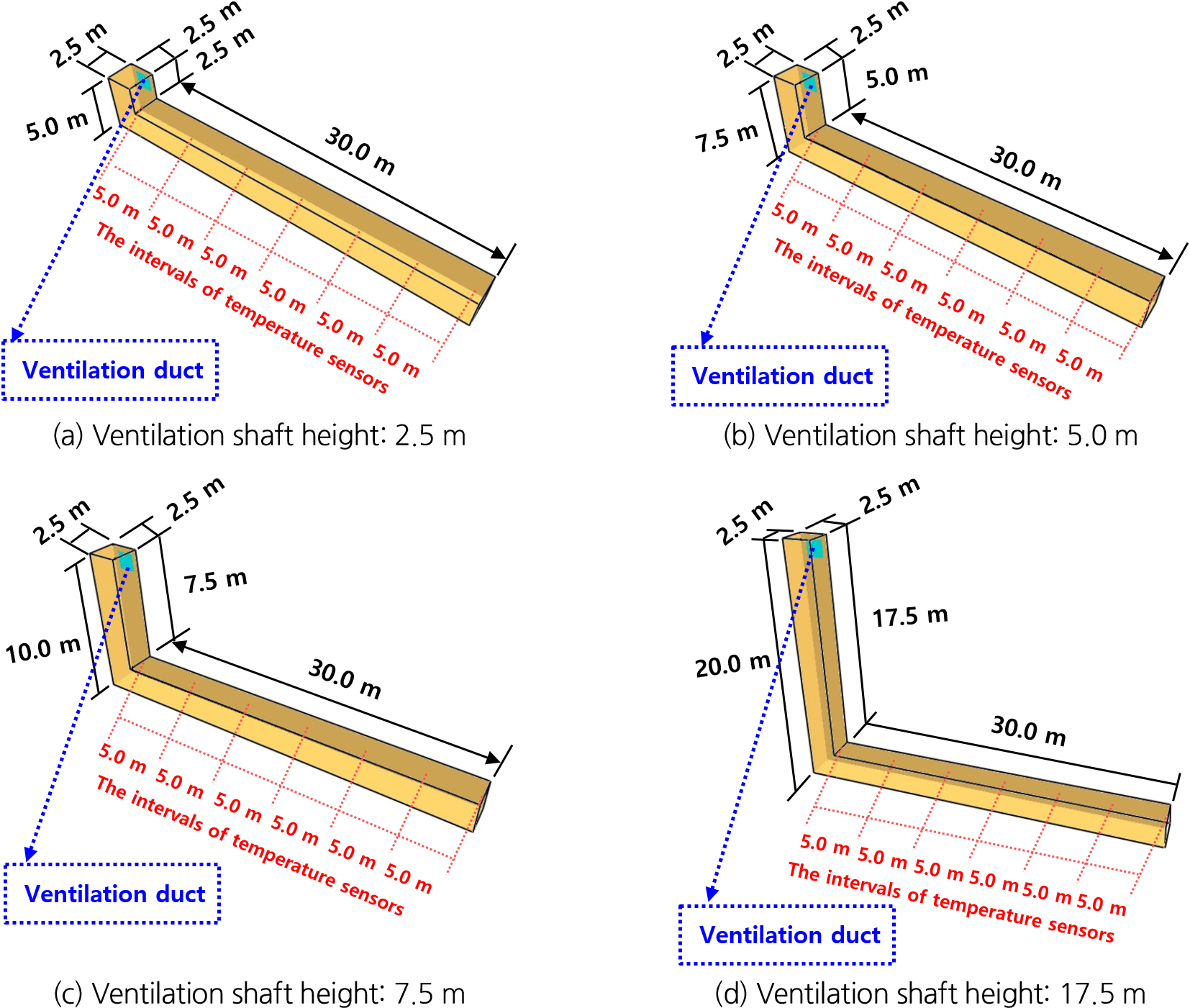
-
Optimization of ventilation control devices for securing response time against condensation in utility tunnels
공동구 결로 대응 시간 확보를 위한 환기 제어장치 최적화 연구
-
Suk-Min Kong, Yoseph Byun, Gi-Jun Lee, Sang-Il Choi, Seong-Won Lee
공석민, 변요셉, 이기준, 최상일, 이성원
- A utility tunnel is an underground facility that accommodates major infrastructure such as power, telecommunications, and water supply in one place. This …
공동구는 전력, 통신, 수도 등 주요 시설물을 한곳에 수용하는 지하 시설이다. 이를 통해 도시 공간을 합리적으로 활용하고, 시설의 보수 및 관리를 용이하게 …
- A utility tunnel is an underground facility that accommodates major infrastructure such as power, telecommunications, and water supply in one place. This enables the rational use of urban space, facilitates maintenance and management of facilities, and helps improve cost efficiency by preventing redundant investments. However, poor management of utility tunnels can cause greater damage than conventional single-purpose ducts. Typical accidents include fire, flooding, and intrusion, but in Korea, many utility tunnel operators consider condensation to be the most serious issue. Condensation is a primary cause of monitoring sensor failures, which in turn can trigger various large-scale accidents such as fire, flooding, and intrusion. In this study, the dry-bulb temperature at which condensation does not occur by ensuring the internal surface temperature of the utility tunnel remains higher than the dew point temperature was calculated in reverse using existing literature and theoretical equations. Computational fluid dynamics (CFD) simulations were conducted to analyze scenarios in which the inflow of hot external air causes the internal conditions of the utility tunnel to shift toward the dry-bulb temperature at which condensation occurs. In addition, the location and airflow rate of ventilation fans were considered as variables to explore optimal strategies for securing response time against condensation. Therefore, the results of this study are expected to provide useful insights for condensation management in the design and operation of utility tunnels.
- COLLAPSE
공동구는 전력, 통신, 수도 등 주요 시설물을 한곳에 수용하는 지하 시설이다. 이를 통해 도시 공간을 합리적으로 활용하고, 시설의 보수 및 관리를 용이하게 하며, 일부 중복 투자를 방지하여 경제성 향상에 도움을 준다. 하지만 체계적이지 못한 공동구 관리는 기존 개별 단독구 보다 더 큰 피해를 가져올 우려도 있다. 공동구에서 대표적인 사고는 화재, 침수, 침입 등이 있으나 국내 공동구를 운영하는 많은 관리자들은 결로 현상을 가장 큰 문제로 생각한다. 결로는 각종 모니터링 센서 고장의 원인이며, 이로 인해 화재, 침수, 침입 등 다양한 대형 사고를 감지 못하는 결과를 초래할 수 있다. 본 연구는 결로에 대한 기존 문헌과 이론식을 통해 건구온도를 역으로 계산하여 공동구 내부에 결로가 발생하지 않는 조건(표면온도 > 노점온도)을 도출하였다. 도출된 건구온도를 바탕으로 전산유체역학(computational fluid dynamics, CFD) 해석을 실시하여 환기구의 높이에 따른 결로 발생까지의 시간을 비교·분석하였다. 또한 환기팬의 위치와 풍량을 변수로 하여 결로 대응 시간을 확보하기 위한 최적 방안을 연구하였다. 따라서 본 결과를 활용한다면, 공동구 설계와 운영 시 결로 발생 상황 대응에 도움을 줄 것으로 기대된다.
-
Optimization of ventilation control devices for securing response time against condensation in utility tunnels
-
Technical Paper

-
Countermeasures for road tunnel floor heave and proposed installation criteria for tunnel invert
도로터널 바닥부 융기 제어 대책과 인버트 설치 기준 제안
-
Hwan-Gu Yu, Hoon-Ki Moon, Tae-Hyung Kim
유환구, 문훈기, 김태형
- Recent cases from long road tunnels in Korea show recurring invert heave attributed to fault zone influence, squeezing, and swelling behaviour. This …
최근 고속국도 장대터널에서 터널 바닥부 융기 현상이 빈번히 보고되고 있으며, 이는 단층대 교차, 지반의 압착(squeezing) 및 팽창(swelling) 거동이 복합적으로 작용한 결과로 분석된다. …
- Recent cases from long road tunnels in Korea show recurring invert heave attributed to fault zone influence, squeezing, and swelling behaviour. This study examines the ○○ Tunnel using construction and operation records, geological investigations, monitoring results, and numerical analyses to clarify the underlying mechanism. Heave was mainly observed near the Oedong, Janghang, Tapjeong, and Yeonil fault zones, and its occurrence was more likely where the competence index was 0.5 to 0.75 or lower. Heave tended to increase one to three months after major rainfall, suggesting that swelling pressure linked to moisture rise is a governing factor. A staged reinforcement concept that includes micropiles and post-maintenance was developed, and criteria for evaluating the need for invert installation were prepared. The findings provide a technical basis for understanding invert heave and establishing practical maintenance guidelines.
- COLLAPSE
최근 고속국도 장대터널에서 터널 바닥부 융기 현상이 빈번히 보고되고 있으며, 이는 단층대 교차, 지반의 압착(squeezing) 및 팽창(swelling) 거동이 복합적으로 작용한 결과로 분석된다. 이러한 융기 거동은 장기적으로 터널의 구조적 안정성과 사용성 저하를 초래하며, 효율적인 유지관리와 보강대책 수립을 위해 융기 원인에 대한 체계적 분석이 필요하다. 본 연구에서는 ○○터널을 대상으로 시공 및 공용 중 조사자료, 지질 분석, 계측 결과, 수치해석을 종합적으로 검토하여 바닥부 융기 발생 메커니즘을 규명하였다. 분석 결과, 융기 구간은 주로 외동·장항·탑정·연일 단층대를 교차하거나 인접한 구간에서 발생하였으며, 컴피턴스 지수(competence index)가 0.5–0.75 이하인 암반에서 융기 가능성이 높게 나타났다. 또한 강우 후 약 1–3개월의 지체시간을 두고 융기가 증가하는 경향이 확인되어 함수비 증가에 따른 팽창압 상승이 주요 요인으로 판단되었다. 국내외 사례 비교를 통해 ‘마이크로파일 + 사후관리’ 개념의 단계별 보강체계를 제안하였으며, 도로터널 인버트 설치 필요성을 정량적으로 검토할 수 있는 판단기준을 마련하였다. 본 연구의 결과는 도로터널 바닥부 융기 문제의 원인 규명 및 실무적 대응기준 정립에 기여할 것으로 기대된다.
-
Countermeasures for road tunnel floor heave and proposed installation criteria for tunnel invert
-
Research Paper
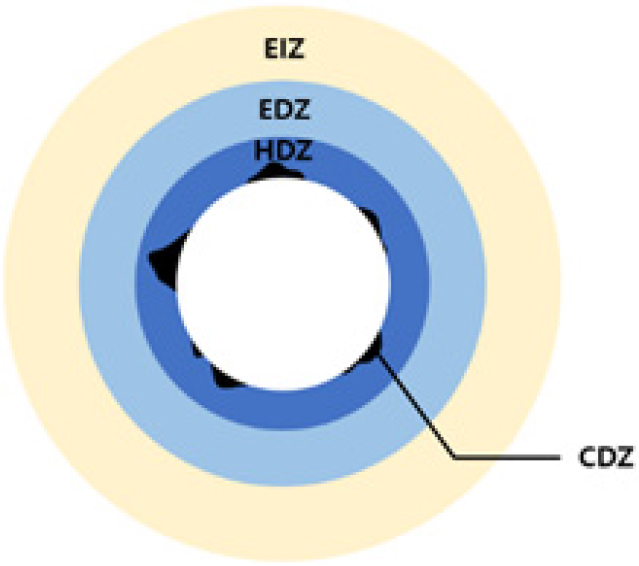
-
A study on the impact of excavation damaged zone (EDZ) on groundwater inflow and optimization of grouting design
굴착손상영역(EDZ)이 지하수 유입에 미치는 영향과 그라우팅 최적화 연구
-
Lymeng Ny, Jin-Sung Kim, Hyoung-Seok Oh, Joon-Shik Moon, Ho-Seok Lee
니리멩, 김진성, 오형석, 문준식, 이호석
- This study aims to quantitatively investigate the impact of the excavation damaged zone (EDZ), formed during tunnel excavation, on groundwater inflow, and …
본 연구는 터널 굴착 시 형성되는 굴착손상영역(excavation damaged zone, EDZ)이 지하수 유입에 미치는 영향을 정량적으로 규명하고, 이에 효과적으로 대응할 수 있는 최적의 …
- This study aims to quantitatively investigate the impact of the excavation damaged zone (EDZ), formed during tunnel excavation, on groundwater inflow, and to propose an optimized grouting design strategy for effective mitigation. Targeting rock mass classes IV and V, this study analyzes the influence of EDZ characteristics, hydraulic property changes, and variations in grouting permeability and thickness by applying analytical equations and PLAXIS 2D-based numerical simulations. The results show that the presence of the EDZ significantly increases groundwater inflow paths, becoming a major factor in tunnel instability. Reducing the permeability of the grouting material and ensuring sufficient grouting thickness were found to be critical in lowering inflow rates. In particular, when the grouting permeability ratio was 1/100 and the thickness exceeded 1.5–2.0 m, more than 95% sealing efficiency was achieved, and the analytical and numerical results showed close agreement. Therefore, this study offers a quantitative grouting design methodology that considers both cost-effectiveness and technical reliability for future tunnel engineering applications.
- COLLAPSE
본 연구는 터널 굴착 시 형성되는 굴착손상영역(excavation damaged zone, EDZ)이 지하수 유입에 미치는 영향을 정량적으로 규명하고, 이에 효과적으로 대응할 수 있는 최적의 그라우팅 설계 방안을 제시하는 것을 목적으로 한다. 암반등급 IV 및 V를 대상으로 EDZ의 특성과 수리적 변화, 그리고 그라우팅의 투수계수 및 두께 변화가 지하수 유입량에 미치는 영향을 PLAXIS 2D 기반 수치해석과 해석식을 통해 비교·분석하였다. 그 결과, EDZ의 존재는 지하수 유입 경로를 확대하여 터널 안정성 저하의 주요 원인이 되며, 그라우팅의 투수성 저감과 충분한 두께 적용은 유입량 감소에 결정적인 영향을 미친다. 특히 그라우팅 투수계수비가 1/100, 두께가 1.5–2.0 m 이상일 경우 95% 이상의 차수 효율이 확인되었으며, 해석식과 수치해석 결과가 유사하게 나타났다. 따라서 본 연구는 향후 터널 설계에 있어서 경제성과 기술적 신뢰성을 고려한 정량적 차수 설계 기법을 제공할 수 있다.
-
A study on the impact of excavation damaged zone (EDZ) on groundwater inflow and optimization of grouting design
-
Research Paper
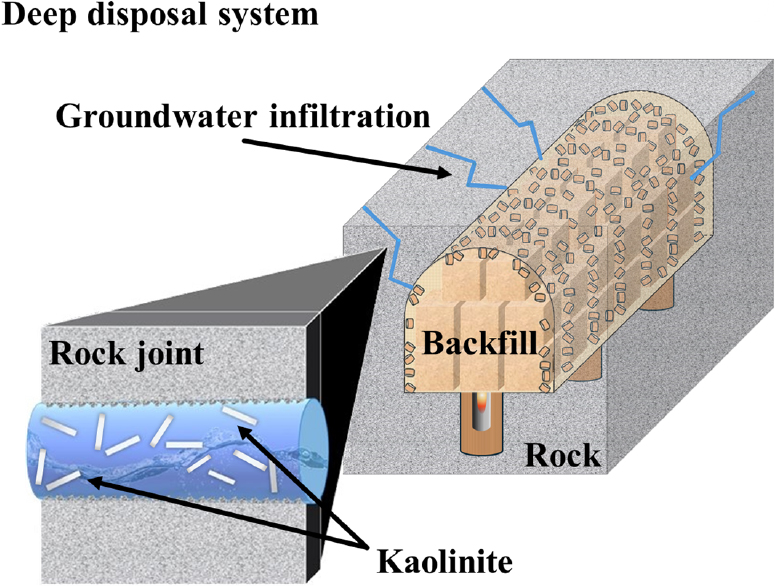
-
Mechanical properties of bentonite-based backfill in deep disposal tunnel according to kaolinite infiltration
카올리나이트 침투에 따른 심층 처분 터널 내 벤토나이트 기반 혼합 뒤채움재의 역학적 물성 평가
-
Jun Sang Yu, Tae-Min Oh, Yohan Cha, Jin-Seop Kim
유준상, 오태민, 차요한, 김진섭
- Deep disposal tunnel that excavated a 500 m tunnel is considered for the high-level radioactive waste. Bentonite-sand mixture is considered as a …
원자력 발전소 가동 후 발생하는 고준위 방사성 폐기물의 처분 방안으로 500 m 대심도 터널을 굴착하여 폐기물을 격납 및 밀봉하는 심층 처분 터널이 …
- Deep disposal tunnel that excavated a 500 m tunnel is considered for the high-level radioactive waste. Bentonite-sand mixture is considered as a backfill material in the deep disposal tunnel. Due to the long-term operation of the deep disposal tunnel, it is essential to understand the thermo-hydro-mechanical-chemical behavior of the backfill material. However, mechanical properties such as elastic modulus and uniaxial compressive strength have been less investigated compared to thermal, hydraulic, and chemical properties. During the operation of the deep disposal tunnel, kaolinite formed by groundwater-induced erosion in granite joints may infiltrate the backfill tunnel and degrade its long-term behavior. In addition, wetting-drying cycles caused by groundwater infiltration and decay heat from radionuclides within the waste can change the density of the backfill, thereby affecting the properties of the bentonite-sand mixture. Kaolinite infiltration and wetting-drying cycles should be considered factors in predicting the long-term behavior of the backfill. Therefore, this study evaluated the liquid and plastic limits of bentonite-kaolinite materials and investigated the elastic modulus and uniaxial compressive strength according to the kaolinite infiltration ratio. The mechanical properties obtained in this study can provide basic data for modeling the long-term behavior of engineered barrier backfills considering mineral infiltration and wetting-drying cycles.
- COLLAPSE
원자력 발전소 가동 후 발생하는 고준위 방사성 폐기물의 처분 방안으로 500 m 대심도 터널을 굴착하여 폐기물을 격납 및 밀봉하는 심층 처분 터널이 고려되고 있다. 심층 처분 터널의 공학적 방벽 중 하나인 뒤채움재의 후보 재료로 벤토나이트에 규사를 혼합하여 활용하는 방안이 채택되어 연구되고 있다. 장기간 운영되는 심층 처분 터널의 특성상, 뒤채움재의 열-수리-역학-화학적 장기 거동 특성에 대한 이해는 필수적이다. 그러나 열-수리-화학적 물성과는 달리, 탄성계수(영률), 일축압축강도 등의 역학적 물성에 대한 연구는 상대적으로 부족한 실정이다. 한편, 심층 처분 터널이 운영되는 동안, 주변 화강암 근계암반 절리 내부에서 지하수의 유동에 의해 발생하는 풍화광물인 카올리나이트가 뒤채움 터널 내부로 침투하여 뒤채움재의 장기 건전성을 저해할 가능성이 있다. 또한, 뒤채움재의 지하수 침투에 의한 포화 및 처분 용기 내부 방사성 핵종에서 발생하는 붕괴열에 의한 건조 과정의 반복은 뒤채움재의 밀도를 변화시켜 역학적 물성 거동에 영향을 미칠 수 있다. 이러한 카올리나이트의 침투 및 포화-건조 과정의 반복은 뒤채움재의 장기 거동 예측에 필수적으로 반영되어야 한다. 따라서, 본 연구에서는 뒤채움재의 벤토나이트 및 카올리나이트 비율에 따른 액·소성한계, 그리고 카올리나이트 침투 질량 분율에 따른 탄성계수 및 일축압축강도에 대한 평가 및 분석을 수행하였다. 본 연구에서 측정한 역학적 물성은 추후 공학적 방벽 뒤채움재의 풍화 광물 침투 및 포화-건조 반복 현상을 반영한 수치해석 모델 개발 시 기초 물성 데이터로 활용될 것으로 기대된다.
-
Mechanical properties of bentonite-based backfill in deep disposal tunnel according to kaolinite infiltration
-
Research Paper

-
Analysis study on the fire scenarios of electric vehicle in underground expressway
지하고속도로 내 전기차 화재 시나리오 수립 연구
-
Jinouk Park, Yongho Yoo, Jioh Yoo, Hyeongje Jo
박진욱, 유용호, 유지오, 조형제
- Due to the globally intensifying environmental issues, the mobility environment on roads is rapidly transitioning from traditional internal combustion engine vehicles (ICEVs) …
전 세계적으로 심화되고 있는 환경문제로 인해 도로 위 모빌리티 환경은 기존 내연기관차에서 친환경차량으로 급속히 변화하는 단계이며, 친환경차 중에서도 전기차 위주로 점유율이 늘어나는 …
- Due to the globally intensifying environmental issues, the mobility environment on roads is rapidly transitioning from traditional internal combustion engine vehicles (ICEVs) to eco-friendly vehicles. Among these, electric vehicles (EVs) are seeing a rapidly increasing market share. Concurrently, the government is planning and promoting underground expressways to alleviate traffic congestion and improve the efficient utilization and connectivity of the ground level. Therefore, EV traffic is expected to increase significantly when these underground expressways, characterized by their ultra-long and deep-level nature, are built and operational. Securing fire safety for eco-friendly vehicles, particularly EVs, in these tunnels is absolutely essential. In this study, to establish plausible EV fire risk scenarios within underground expressways, we analyzed domestic and international EV fire accident statistics and preceding research results. Based on this analysis, we proposed a strategic direction for developing fire scenarios categorized by EV-specific risk factors.
- COLLAPSE
전 세계적으로 심화되고 있는 환경문제로 인해 도로 위 모빌리티 환경은 기존 내연기관차에서 친환경차량으로 급속히 변화하는 단계이며, 친환경차 중에서도 전기차 위주로 점유율이 늘어나는 추세이다. 이와 더불어 정부는 교통 정체 해결 및 지상의 효율적 활용과 연결을 위해 지하고속도로를 계획하고 추진하고 있다. 따라서, 지하고속도로가 건설되어 이용될 시기에는 전기차 통행이 상당히 증가할 것으로 예상되며, 초장대 및 대심도의 특성을 가지는 지하고속도로에서의 친환경차 화재 안전성 확보는 필수적이다. 본 연구에서는 지하고속도로 내에서의 타당한 전기차 화재 위험 시나리오 수립을 위해 국내외 전기차 화재 사고 및 통계와 선행연구 결과를 분석하여, 터널 특성 및 전기차 화재 위험 특성을 반영한 화재 시나리오를 제시하였다.
-
Analysis study on the fire scenarios of electric vehicle in underground expressway
-
Research Paper
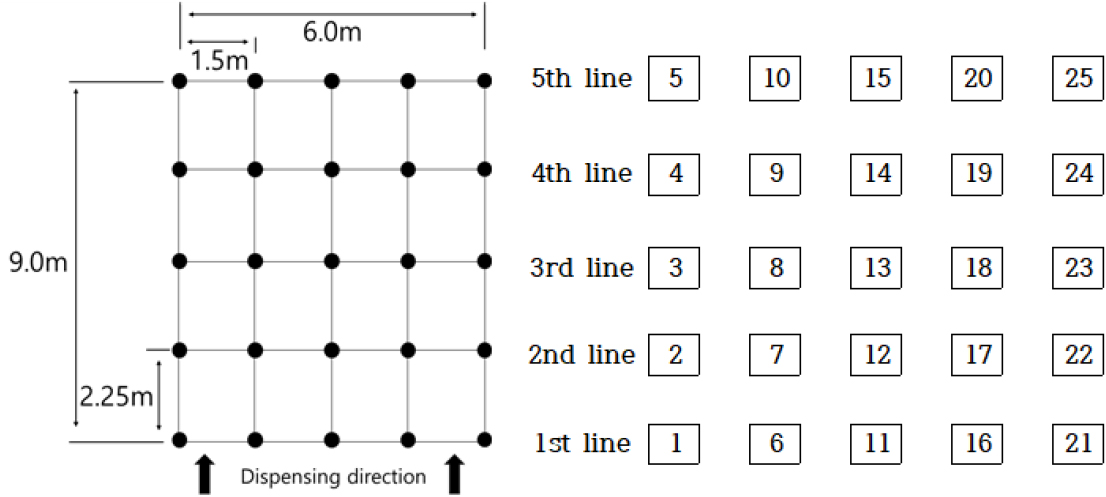
-
Experimental study on uniform spray distribution improvement in road tunnel water spray fixed systems for fire protection
도로터널 물분무소화설비의 살수밀도 균일성 개선에 관한 실험적 연구
-
Geonho Kim, Jinouk Park, Hwiseong Kim, Donghun Seok, Yongho Yoo, Sangheon Park, Kidon Kim
김건호, 박진욱, 김휘성, 석동훈, 유용호, 박상헌, 김기돈
- Tunnel construction in Korea has more than doubled over the past decade, heightening fire-risk concerns in semi-enclosed spaces with restricted ventilation. The …
국내 도로교통 인프라 확충과 함께 터널 건설은 지난 10년간 급증하였다. 2014년 약 1,800여 개소였던 터널은 2023년 약 3,800여 개소로 두 배 이상 …
- Tunnel construction in Korea has more than doubled over the past decade, heightening fire-risk concerns in semi-enclosed spaces with restricted ventilation. The Guidelines for Design and Maintenance of Road Tunnel Fire Protection and Ventilation Systems mandate water-spray systems in first-grade tunnels; however, prior studies report non-uniform spray density and zones failing the 6.0 L/min·m·criterion, with added limitations for electric vehicle (EV) battery-fire scenarios. This study experimentally compares conventional fixed systems with a next-generation system under identical conditions (nozzle inlet pressure 0.35 MPa; discharge rate 390 LPM). Spray distribution is evaluated on a standardized 25-tray grid (0.09 m2 each), converting collected volume per unit area and time to spray density. Results show the next-generation system significantly improves spray-density uniformity and reduces deficient zones; residual deficiencies near far-side shoulders indicate the need to further optimize spray angle and discharge cycle. These findings demonstrate the system’s effectiveness and motivate large-scale, in-situ validation linked to EV-battery fire suppression to inform future tunnel fire-safety standards.
- COLLAPSE
국내 도로교통 인프라 확충과 함께 터널 건설은 지난 10년간 급증하였다. 2014년 약 1,800여 개소였던 터널은 2023년 약 3,800여 개소로 두 배 이상 증가하였으며, 총 연장 역시 1,200 km 이상으로 확대되었다. 터널 화재는 반밀폐 구조와 환기 흐름의 제약으로 인해 대형 인명 및 재산 피해로 비화할 위험이 높다. 이에 「도로터널 방재·환기시설 설치 및 관리지침」은 1등급 터널의 물분무소화설비 설치를 의무화하고 있으나, 선행연구에서는 방수구역별 살수밀도의 불균일성과 성능기준(6.0 L/min·m2) 미달 구역의 존재를 지적해 왔다. 더불어, 변화하는 교통 환경에 대한 전기차(electric vehicle, EV) 배터리 화재 및 구조적 사각지대 대응에 대한 한계는 더욱 취약한 실정이다. 본 연구는 동일한 운전 조건(노즐 전단 0.35 MPa, 유량 390 LPM)에서 기존 고정식 물분무소화설비와 차세대 물분무소화설비를 대상으로 방수구역 내 살수밀도를 실험적으로 비교 분석하였다. 표준화된 트레이 격자(25구역, 0.09 m2/구역)에서 분당 단위면적당 수량을 계측·환산하여 분포특성 및 취약개소를 평가하였다. 그 결과, 차세대 물분무소화설비의 살수밀도 균일성이 유의하게 향상되었으며 기준 미달 취약개소의 발생 빈도가 현저히 감소하였다. 다만, 노즐 원접 길어깨 구역의 취약개소가 잔존하여 분사각도, 분사주기 최적화가 필요함을 확인하였다. 본 연구는 터널용 물분무소화설비의 살수밀도를 정량적으로 비교 분석하여 차세대 물분무소화설비의 실효성을 실험적으로 입증하였다. 또한, 향후 실제 환경 반영의 실증과 EV 배터리 소화 성능과의 연계 검증을 통해 터널 화재안전 설계 및 운영 기준의 고도화에 기여할 수 있음을 시사한다.
-
Experimental study on uniform spray distribution improvement in road tunnel water spray fixed systems for fire protection
-
Technical Paper
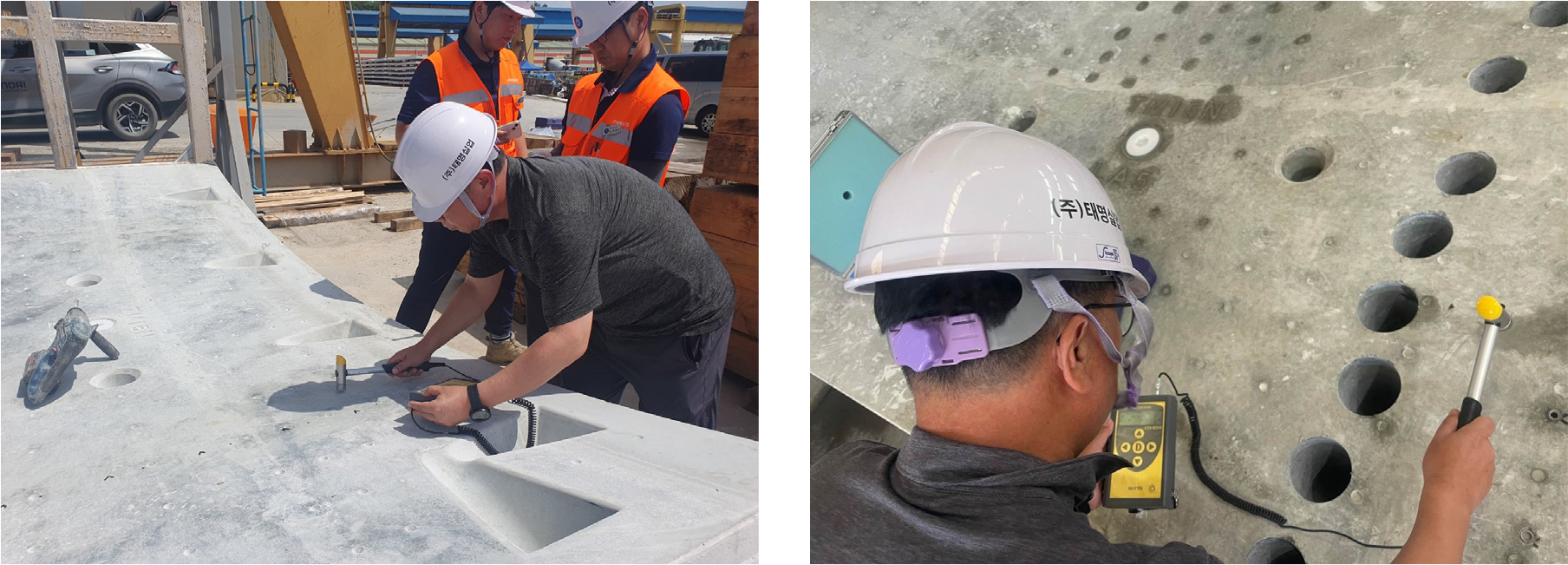
-
A study on the evaluation method of compressive strength of TBM segment linings using nondestructive testing
비파괴 검사를 이용한 TBM 세그먼트 라이닝의 압축강도 평가 방안 연구
-
Jee-Hee Jung, Kang-Hyun Lee, Hong Sam Kim, Sung-Min Nam, Jin-Woo Jung
정지희, 이강현, 김홍삼, 남성민, 정진우
- In recent years, the demand for underground road construction has increased to alleviate urban traffic congestion and improve land use efficiency. As …
최근 도심지 교통 혼잡 완화와 지역 단절 해소 등을 위해 도로 지하화 사업이 증가함에 따라 터널 굴착시 TBM (tunnel boring machine) 공법의 …
- In recent years, the demand for underground road construction has increased to alleviate urban traffic congestion and improve land use efficiency. As a result, the application of tunnel boring machine (TBM) tunneling has expanded, particularly in dense urban environments where blasting-based new Austrian tunneling method (NATM) construction is difficult. In TBM tunnels, the precast concrete segment lining directly resists ground and structural loads, making the verification of its mechanical strength and durability essential for overall tunnel safety. However, current on-site quality inspection primarily relies on visual assessment, which has limitations in evaluating structural integrity. This study examined various nondestructive testing (NDT) methods to evaluate the compressive strength of TBM segment linings and selected the mechanical impedance method due to its applicability to high-strength curved concrete segments. Core samples were also extracted from the same segments to perform destructive compressive strength tests, and correlation analysis was conducted. The results showed that the compressive strength correlation at 56 days exhibited the highest coefficient of determination (R2 = 0.93). Based on this result, a practical on-site NDT-based compressive strength quality control criterion was proposed.
- COLLAPSE
최근 도심지 교통 혼잡 완화와 지역 단절 해소 등을 위해 도로 지하화 사업이 증가함에 따라 터널 굴착시 TBM (tunnel boring machine) 공법의 적용이 확산되고 있다. TBM 터널에서 세그먼트 라이닝은 지반 하중, 수압 등의 하중을 직접 지지하는 구조적 역할을 수행하기 때문에, 현장 반입 단계에서의 강도 및 건전성 평가는 터널의 장기적 안전성 확보에 매우 중요하다. 그러나 기존 현장 반입 단계에서의 품질관리는 외관 중심의 정성적 검사가 주를 이루고 있어 구조 성능을 정량적으로 확인하기 어렵다는 한계가 있다. 이에 본 연구는 세그먼트 라이닝의 현장 강도 평가를 위해 비파괴검사(기계임피던스법) 방법을 적용하고, 동일 세그먼트에 대해 수행한 코어 공시체 압축강도 시험 결과와의 상관관계 분석을 통해 품질관리기준을 제시하였다. 분석 결과, 재령 56일 선행 압축강도 시험에서 결정계수(R2)가 0.93으로 가장 높은 상관성을 보였으며, 이를 바탕으로 현장 비파괴검사 결과의 압축강도 관리기준을 도출하였다.
-
A study on the evaluation method of compressive strength of TBM segment linings using nondestructive testing
-
Research Paper

-
A study on the application of standard emission factors in road tunnels considering the adoption rate of eco-friendly vehicles
친환경차량 보급률에 따른 도로터널 기준배출량 적용에 관한 연구
-
Hyo-Gyu Kim
김효규
- To maintain air pollutant concentrations inside road tunnels below acceptable levels, the required ventilation capacity is estimated using the concept of the …
도로터널은 터널내 체류하는 오염물질의 농도를 일정 수준 이하로 유지하기 위하여 필요한 최소한의 용량을 산정하기 위하여 소요환기량이란 개념을 통해 환기용량을 산정한다. 이 때 …
- To maintain air pollutant concentrations inside road tunnels below acceptable levels, the required ventilation capacity is estimated using the concept of the necessary ventilation flow rate. This flow rate is calculated by converting mass-based emission factors defined as “standard emission rates” in relevant legal guidelines. As multiple regulations have recently been revised, newly established, or present differing criteria, a comparative review is required. Furthermore, the increasing adoption of eco-friendly vehicles and the resulting decline in internal combustion engine vehicles necessitate updated evaluations of fuel- and vehicle-type-specific emissions. This study analyzes and compares standard emission rates derived from the currently applied regulations—“Emission Standards for Manufactured Vehicles (2019)” and “Emission Standards for Manufactured Vehicles (2024)”—as well as the newly introduced guideline, the “Manual for Estimating Air Pollutant Emission Factors (2023)”, based on recent trends in registered vehicle populations by type. The results indicate that, compared to the current emission standards (2019), the newly established “Road Mobile Source Emission Factors (2023)” show reductions of up to 60% in standard emission rates for all pollutants (PM, CO, NOx) and vehicle categories, except for NOx emissions from small truck. The anomaly observed for small truck is presumed to stem from overestimated or erroneous emission factor values within the guideline. This study is expected to serve as foundational data for future estimation of required tunnel ventilation flow rates and ventilation capacity planning, taking into account ongoing regulatory updates and the increasing share of eco-friendly vehicles.
- COLLAPSE
도로터널은 터널내 체류하는 오염물질의 농도를 일정 수준 이하로 유지하기 위하여 필요한 최소한의 용량을 산정하기 위하여 소요환기량이란 개념을 통해 환기용량을 산정한다. 이 때 소요환기량은 관련 법정 규정에 따라 기준배출량이란 질량단위 배출량을 단위환산하여 산정이 된다. 이를 위한 규정은 현행 적용 중인 기준과 개정된 사항, 그리고 관련 하여 유사 규정의 신규 제정이 있어 이에 대한 비교 및 고찰이 필요하다. 또한 최근 친환경차량의 보급률 증대로 내연기관의 감소에 따른 연료에 대한 차종별 검토 역시 필요한 실정이다. 본 연구에서는 친환경차량 보급률 증대에 따라 최근 등록된 자동차 누적대수 등록추이를 기반으로 현행 적용 중인 관련 규정(제작차 배출허용기준(2019), 제작차 배출허용기준(2024))과 유사 규정의 신규 규정(국가 대기오염물질 배출량 산정방법 편람(VI)(2023))에 따른 기준배출량을 산정하여 비교 및 검토하였다. 그 결과 현행 기준인 ‘제작차 배출허용기준(2019)’ 대비 제정된 ‘국가 대기오염물질 배출량 산정방법 편람(VI)(2023)’의 기준배출량 변화는 NOx의 소형트럭을 제외한 모든 오염물질(PM, CO, NOx) 및 차종에서 최대 60% 이상의 기준배출량이 감소될 것으로 분석되었으며, 소형트럭의 경우 해당 규정에서 제시한 배출계수의 과도예측 또는 단순 오류라 판단된다. 본 연구는 도로터널의 환기용량을 결정짓기 위한 관련자료의 개정현황 등을 고려하여 향후 친환경차량이 증대되는 추세를 고려하여 미래 도로터널 소요환기량 산정 및 환기용량 도출의 기초자료로 활용 될 것으로 예상된다.
-
A study on the application of standard emission factors in road tunnels considering the adoption rate of eco-friendly vehicles
Journal Informaiton
 Journal of Korean Tunnelling and Underground Space Association
Journal of Korean Tunnelling and Underground Space Association
Journal Informaiton
Journal Informaiton - close
 Journal of Korean Tunnelling and Underground Space Association
Journal of Korean Tunnelling and Underground Space Association











